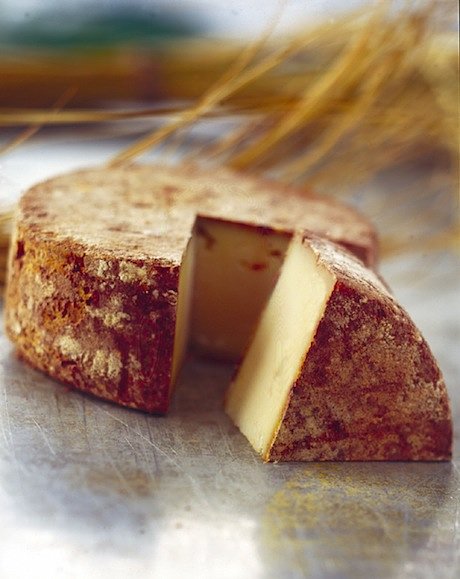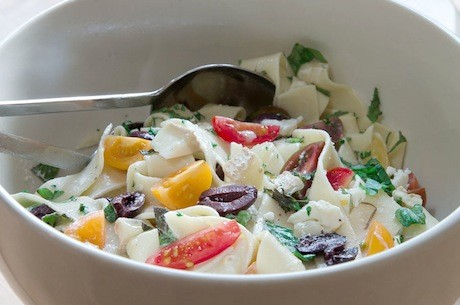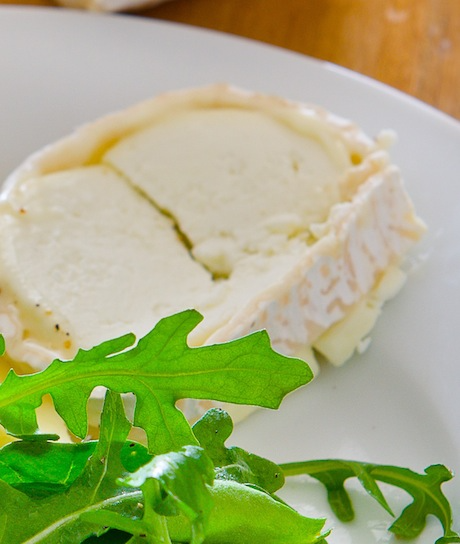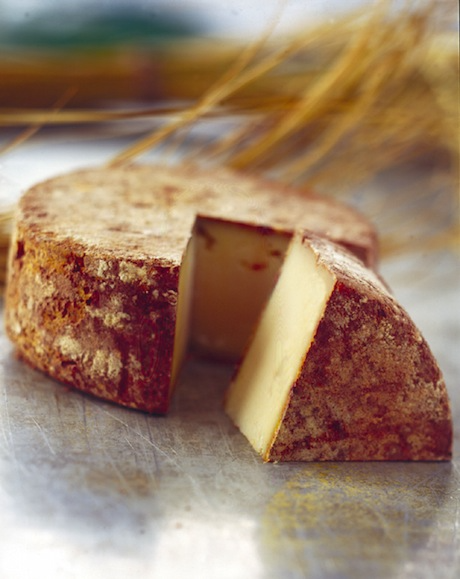The Best Goat Cheese for Your Recipes

Thu 5 Sep 2013
So, somewhere on some trip to France, you fell in love with goat cheese in all its funky, nutty, tangy and luscious glory. Perhaps it arrived in oozy-melty disks on toasts perched atop a salad. Maybe a slightly bulging wedge of it rolled up to your table on a restaurant’s chariot de fromage. Or maybe you tasted its unmistakable richness and complexity in a recipe.

Summer Tomato Pasta with French Goat Cheese and Herbs. Photo: Richard Swearinger.
However you got your first whiff and taste of the treat, you vowed to enjoy it more often once you landed back in wherever you call home. Trouble is, with more than 3,000 goat cheese producers in France—located all over the country—how were you going to find one akin to the beauty that first stole your heart?
It helps to know the three main categories of goat cheese: fresh, semiripened, and aged. Certainly, within each style, the cheeses themselves can vary depending on what the animals eat, where the cheeses are made, the recipe and how long they are aged. But once you learn to recognize—by sight—these three categories, you’ll soon land a style you’ll love, and know which style to use when you cook.
Fresh Goat Cheese (aka Fresh Chèvre)
What it is: Fresh goat cheese that is so young it has not yet developed a rind. It is often sold in tubes at the supermarket.
Appearance/flavor: Rindless, chalky white, and tangy tart in flavor.
Use for
• Salads: It is especially good for salads that call for crumbled fresh goat cheese. But you can’t really crumble it (like a blue cheese). Instead, break it into crumbles with your fingers or a knife.
• As a spread: Whip it with a little cream to make a spread for crackers, then top with fun complements like tomatoes, fresh herbs, tapenade, sliced balsamic-marinated fruit and more.

Semiripened Goat Cheese (aka Soft-Ripened Goat Cheese, Semiaged Goat Cheese)
What it is: As the cheese ages, air naturally dries out the exterior of the cheese, forming a soft edible rind (when young) or a hard, nonedible rind when older.
Appearance/flavor
• Chalky white inside, but often a soft, luscious layer toward the exterior of the cheese.
• More complex and deeply flavored than fresh chèvre. The longer it has aged, the bolder the flavor.
• Shapes and sizes go well beyond the log. Examples include bouchon (cork), coeur (heart), clochette (small bell) and quatre feuilles (four-leaf clover).
• Sometimes these cheeses are coated in a sprinkle of edible gray ash, which helps cut down on the their acidity while promoting their aging process. Other times, the cheeses have been treated specifically to form a bloomy rind—akin to Brie or Camembert.
Use for
• Salads: Just like fresh goat cheese, semiaged goat cheese works well—cut and/or crumbled—in salads. This variety is also my number one choice when the cheese is going to be warmed, as in salade au chèvre chaud—the classic warmed goat cheese salad.
• Cooking: With more interesting flavors and better meltability than fresh goat cheese, it’s a great choice for recipes when the cheese will be heated (see Summer Tomato Pasta with French Goat Cheese and Herbs below).
• Cheese trays: A great choice for the cheese course.

Aged Tomme.
Aged Goat Cheese: The Tommes and the Blues
• Tommes are large wheels of aged, pressed, semihard to hard cheeses that have hard, inedible rind. These full-flavored cheeses are often difficult to find outside France. If you do get your hands on some, enjoy them in cooking (they melt well) and on a cheese tray.
• Blue: Also somewhat rare outside France, bleu de chèvre is a blue-veined goat cheese than can be enjoyed like other blue cheeses, although they’re milder in taste.
For more information on French goat cheeses, visit the website of the Original Chèvre (see link below).
Summer Tomato Pasta with French Goat Cheese and Herbs
Here’s a luscious way to enjoy semiripened goat cheese in a summery preparation. The hot pasta helps the cheese meld with the olive oil and release the fragrance from the herbs for an irresistible sauce. It’s from The Bonne Femme Cookbook: Simple, Splendid Food That French Women Cook Every Day.
Makes 4 servings.
8 ounces tripolini or tagliatelle pasta
3/4 pound assorted ripe summer tomatoes, such as heirloom tomatoes and red and yellow cherry and pear-shaped tomatoes, chopped
1/4 cup pitted, chopped imported black olives
2 tablespoons snipped fresh parsley
2 tablespoons snipped fresh chives
1 teaspoon snipped fresh rosemary
1 teaspoon snipped fresh thyme
2 tablespoons extra-virgin olive oil
2/3 cup crumbled soft-ripened French goat cheese
Salt and freshly ground black pepper to taste
1. Bring a large pot of water to a boil and cook the pasta according to the package directions.
2. Meanwhile, in a large bowl combine the tomatoes, olives, parsley, chives, rosemary, thyme and olive oil. Stir to combine. Gently stir in the cheese.
3. Drain the pasta and add to the bowl with the sauce; toss gently to combine. Season with salt and pepper. Serve in wide, shallow bowls.
Related link
The Original Chèvre
Wini Moranville is the author of The Bonne Femme Cookbook: Simple, Splendid Food That French Women Cook Every Day. Follow her on Facebook at Chez Bonne Femme, on Twitter @winimoranville and visit her blog.
Editor’s note: Do you follow us yet on Tumblr, Pinterest and Instagram? If not, why wait? It’s free, fun and a beautiful reminder of our favorite city—Paris of course!